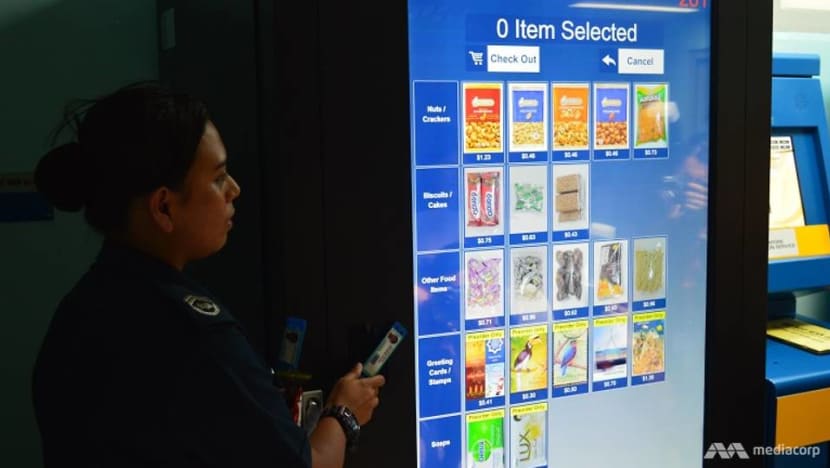How Changi Prison is taking to video analytics and facial recognition in a big way
Prison surveillance is going high-tech with smart systems that could help officers be more aware of inmates' behaviours as part of moves to transform operations.

This Avatar system uses prototype video analytics to detect fights in cells. (Photo: Amir Yusof)
SINGAPORE: Family visits can be joyful moments for prisoners, or filled with tension. How a visit turns out, however, may not always be so obvious to the officers supervising the inmates.
That could change, as the Singapore Prison Service (SPS) is now exploring the use of video analytics to help its officers be more aware of inmates’ behaviours.
If the technology works accurately, the SPS envisions using it to improve the management of inmates throughout the Changi Prison Complex.
It would be the most comprehensive use of video analytics in the prison since the SPS set out in 2017 to transform its operations through technological initiatives.

This comes as Singapore goes into facial recognition technology in a big way, with a project lined up to fit cameras and sensors on more than 100,000 lamp-posts, to help authorities “perform crowd analytics” and support anti-terror operations.
READ: 'Smart lamp posts' in Singapore won't shine light into people's lives
READ: ICA to introduce multi-biometrics screening at checkpoints from April 2019
In prison, the technology could play a similar analytics role, Deputy Superintendent of Prisons 2 (DSP 2) Neo Ming Feng disclosed to the programme Why It Matters in a web exclusive.
“With more data coming in through sensors, through biometrics, through closed-circuit television, we can fuse the data and analyse it, and assist our officers through a better ground situation awareness of what’s going on,” said the 32-year-old.
PICKING UP ABNORMAL BEHAVIOUR
For example, one of the things officers look out for is “the way inmates respond to how their families are doing”.
“Let’s say, after a visit and the inmates come back slightly depressed or looking unhappy, that’s when we can pick up signs of … the inmates behaving abnormally,” said DSP 2 Neo, the SPS’ assistant director of transformational projects.
“Our officers can intervene to understand what’s happening or what the inmate is going through, and that can better help inmates.”

Video analytics could help prison officers to better understand how inmates behave in general, for example in their cell or in the day room, which is the area right outside their cells.
“Once we know the normal behaviour of the inmate, when the inmate behaves abnormally, we could then pick up the difference,” explained DSP 2 Neo.
The information could alert officers that they “probably need to pay more attention to the inmate, to pre-empt incidents that could happen”.
The technology could also identify more accurately whom an inmate communicates with usually. “With that, we can learn more about the dynamics of the inmates’ interactions … (and) the dynamics of the whole prison,” said DSP 2 Neo.

Deploying video analytics would also assist officers in the control centre in identifying whether any inmates are going to an area of the prison where they are not supposed to be.
The prison staff are “generally very supportive of this project”, as they understand how it will help them, added DSP 2 Neo.
Although the vision is clear, the SPS has not implemented this system just yet.
So far, Changi Prison has been doing trials on facial recognition to determine whether an automated system can replace the muster checks done manually by officers to account for inmates.
Using the technology, cameras in the cells capture the inmates’ facial images and verify them with the database. This allows the checks, which must be repeated a few times daily, to be done faster.

DETECTING FIGHTS
Besides that, a human behaviour detection system called Avatar is being tested. It uses video analytics to detect abnormal activities – such as fights – in the cells and to alert the officers.
READ: Changi Prison raises tech bar with automated checks, surveillance system that detects fights
To do this, the system must be taught to recognise aggression, explained Mr Benjamin Lee, the assistant director of human performance at the Home Affairs Ministry’s Office of the Chief Science and Technology Officer.
“From a human perspective, we kind of understand what aggression is. So there’s motion … it’s chaotic, it has a high number of interaction points. So we try to translate that into what we think a computer should understand,” he said.
Avatar is being tested in one prison cell, and it was reported in June that it has detected actual fights. But there have also been false positives.
“That’s one of the challenges that we see. So, for example, if an inmate’s doing jumping jacks in the cell, we see that being classified as … an act of aggression,” said Mr Lee.
“What we can do is to take all these false positives and feed them back to the system, and teach it to recognise that these aren’t real acts of aggression.”
Videos of fights are also fed into the system, and brawls are simulated, “to continually train the system to become more and more intelligent” and to test its accuracy.
“We’re still in the process of fine-tuning the algorithm,” added Mr Lee, who admitted that there are still times when the computer does not pick up acts of aggression.
When it is “accurate enough”, it will be put into full operation, said DSP 2 Neo, who highlighted that it will serve the SPS’ mission to ensure the “secure custody of the inmates” – besides rehabilitating them – “for a safer Singapore”.
Watch the Why It Matters episode on facial recognition technology here. And read about how China is powering up on facial recognition, from dispensing toilet paper to shaming jaywalkers.

















